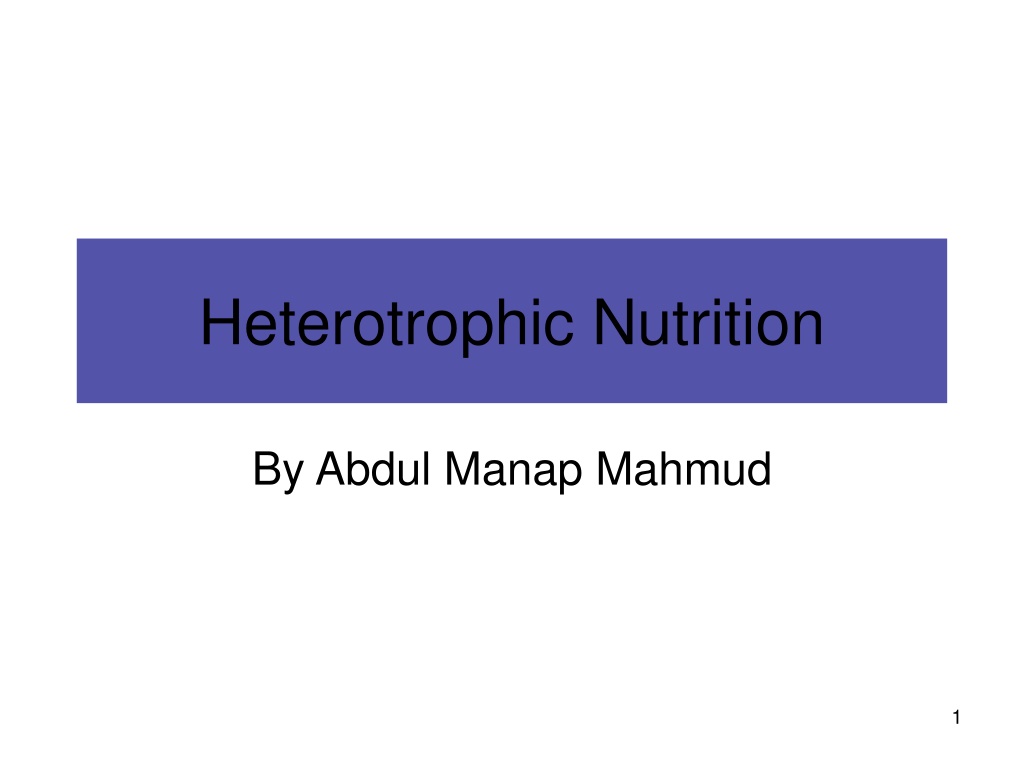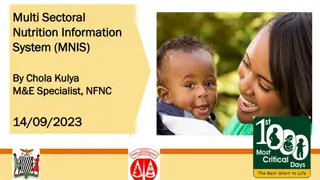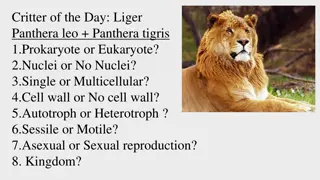Understanding Heterotrophic Nutrition in Organisms
Heterotrophic nutrition refers to the process where organisms, such as animals, rely on preformed organic molecules from their environment or other organisms for nutrients and energy. These organisms are unable to produce organic compounds from inorganic sources and must obtain nourishment from external organic substances. The concept of heterotrophic nutrition explores the dependence of certain organisms on organic material for survival and growth, contrasting them with autotrophic organisms that can generate their own food through photosynthesis or inorganic chemical reactions. The source of carbon for living things is crucial, with carbon being extracted from the nonliving environment and recycled to sustain life.
Download Presentation

Please find below an Image/Link to download the presentation.
The content on the website is provided AS IS for your information and personal use only. It may not be sold, licensed, or shared on other websites without obtaining consent from the author. Download presentation by click this link. If you encounter any issues during the download, it is possible that the publisher has removed the file from their server.
E N D
Presentation Transcript
Heterotrophic Nutrition By Abdul Manap Mahmud 1
Introduction Definitions of heterotrophic on the Web: Refers to organisms, such as animals, that depend on preformed organic molecules from the environment (or another organism) as a source of nutrients/energy. www.emc.maricopa.edu/faculty/farabee/BIOBK/BioBookglossH.html Requiring organic substrates for growth and development; being incapable of synthesizing required organic materials from inorganic sources. (20) ppathw3.cals.cornell.edu/glossary/Defs_H.htm obtaining nourishment from organic substances, not from food produced within the organism. www.dfo-mpo.gc.ca/canwaters-eauxcan/bbb-lgb/library- bibliotheque/glossary-glossaire/index_e.asp 2
Introduction unable to derive energy from photosynthesis or from inorganic chemical reactions, and so dependent on energy-containing organic compounds derived from the current or prior existence of other organisms, cf. AUTOTROPHIC. www.mycolog.com/GLOSSARY.htm Describing consumers, organisms that cannot synthesize food from inorganic materials and therefore must use the bodies of other organisms as a source of energy and body-building materials.* biology.usgs.gov/s+t/noframe/z999.htm An organism incapable of producing organic compound from inorganic materials and thus must rely on other living or dead organisms for its food supply.www.botanyvt.com/pages/dictionary.shtml requiring ready formed organic food. gmbis.marinebiodiversity.ca/BayOfFundy/glossE-H.html 3
Source of Carbon The concentration of carbon in living matter (18%) is almost 100 times greater than its concentration in the earth (0.19%). So living things extract carbon from their nonliving environment. For life to continue, this carbon must be recycled. 6
Source of Carbon Carbon exists in the nonliving environment as: Carbon dioxide (CO2) in the atmosphere and dissolved in water (forming HCO3 ) Carbonate rocks (limestone and coral = CaCO3) Deposits of coal, petroleum, and natural gas derived from once-living things Dead organic matter, e.g., humus in the soil 7
Source of Carbon Carbon enters the biotic world through the action of autotrophs: primarily photoautotrophs, like plants and algae, that use the energy of light to convert carbon dioxide to organic matter. and to a small extent, chemoautotrophs bacteria and archaeans that do the same but use the energy derived from an oxidation of molecules in their substrate. 8
Source of Carbon Carbon returns to the atmosphere and water by Respiration (as CO2) Burning Decay (producing CO2 if oxygen is present, methane (CH4) if it is not. 9
Source of Carbon Definitions of Chemoheterotroph on the Web: A chemoheterotroph is an organism that must consume organic molecules for both energy and carbon. en.wikipedia.org/wiki/ Chemoheterotroph
Omnivores Definitions of Omnivores on the Web: Animals that feed on material of both plant and animal origin www.ecifm.rdg.ac.uk/glossary.htm Animals that eat many different kinds of foods, including plants, insects, and other animals. www.nps.gov/olym/edgloss.htm Eats live prey and plants boxturtlesite.org/glos.html The category of animals that feed on both plants and animals. (omni-, all; -vore, eater) www.dfr.state.nc.us/stewardship/wwwildlife/www13.htm such as bears and humans, eat both meat and plants. www.teachervision.fen.com/page/5485.html Omnivores are organisms that consume both plants and animals. en.wikipedia.org/wiki/Omnivores
Omnivores Omnivores eat plants, but not all kinds of plants. Omnivores can't digest some of the substances in grains or other plants that do not produce fruit. They can eat fruits and vegetables, though. Some of the insect omnivores in this simulation are pollinators, which are very important to the life cycle of some kinds of plants. Large Omnivores
Omnivores Some animals don t fit neatly into a single category because they have wider tastes. These animals, that feed on a combination of plants and animals, are called Omnivores.
Carnivores Definitions of carnivores on the Web: Term applied to a heterotroph, usually an animal, that eats other animals. Carnivores function as secondary, tertiary, or top consumers in food chains and food webs. www.emc.maricopa.edu/faculty/farabee /BIOBK/BioBookglossC.html Animals that feed on other animals or material of animal origin. www.ecifm.rdg.ac.uk/glossary.htm Organisms that mainly prey upon animals. highered.mcgraw- hill.com/sites/0070294267/student_view 0/glossary_a-d.html
Carnivores Animals and a few plants that consume dead or living animal food. museum.gov.ns.ca/mnh/nature/nhns2/g lossary.htm carnivores feed strictly on meat www.fi.edu/fellows/fellow6/feb99/terms 1.html The category of animals that prey or feed upon animals and insects. (carni-, flesh; vore-, eater) www.dfr.state.nc.us/stewardship/wwwil dlife/www13.htm Meat eaters www.promotega.org/uga30006/Vocabul ary.htm
Carnivores are flesh-eating animals, like lions. www.teachervision.fen.com/page/5485. html These are animals and mammals that eat other animals and mammals, also called flesh-eaters ; see food chain www.recycle4schools.org.uk/ecodict_c. htm Animals that have meat as the main part of their diet. www.tictoc.co.uk/Phase3/Resource/glo ssary.html Carnivores are animals that eat a diet consisting mostly of meat. en.wikipedia.org/wiki/Carnivores
Symbiosis Definitions of symbiosis on the Web: A mutually beneficial association of two different kinds of organisms. www.planthealthcare.com/terms.html To live together; a condition in which two animals, two plants, or a plant and an animal live in partnership. The relationship can be that of commensalism, where one organism benefits from activities of the other; parasitism, where one organism lives on another to the detriment of its host; or mutualism, where both organisms benefit from the association. www.fish.washington.edu/naturemapping/mollusks/glossary.html the living together of unlike organisms in a close, long-lasting association. www.anbg.gov.au/glossary/webpubl/lichglos.htm
Symbiosis The intimate living together of two dissimilar organisms in a mutually beneficial relationship. www.visionlearning.com/library/pop_glossary_term.php An interactive association between two or more species living together; may be parasitic, commensal, or mutualistic. The relationship between two organisms. www.emc.maricopa.edu/faculty/farabee/BIOBK/BioBook glossS.html An ecological relationship between organisms of two different species that live together in direct contact. nationalzoo.si.edu/Animals/Primates/glossary.cfm
Symbiosis A mutually beneficial relationship between two organisms. www.powen.freeserve.co.uk/Reference/Glossary /gloss-s.htm A close, prolonged association between two or more different organisms of different species that may, but does not necessarily, benefit each member. www.freakinfucus.co.uk/primers/prm_gloss.htm
Symbiosis Most of the interactions between species involve food: competing for the same food supply eating (predation) avoiding being eaten (avoiding predation)
Symbiosis In symbiosis, at least one member of the pair benefits from the relationship. The other member may be injured = parasitism relatively unaffected ( = commensalism) may also benefit ( = mutualism).
Symbiosis Mutualism Symbiotic relationships in which each species benefits are mutualistic. There are hundreds of examples of mutualism between a heterotroph and an alga.
Symbiosis Paramecium bursaria is a ciliate that engulfs unicellular green algae into vacuoles within its cell. The paramecium certainly benefits from the food synthesized by the alga. It can be cultured apart from the alga but then must be given extra food. The alga presumably benefits from the carbon dioxide produced by its host as well as the host's ability to transport it to a spot where there is ample light.
Symbiosis Many other aquatic heterotrophs sponges sea anemones planarians clams also harbor algae within their cells.
Symbiosis liberating toxins, for example, Tetanus bacilli secrete tetanus toxin which interferes with synaptic transmission. Diphtheria bacilli secrete a toxin that inhibits protein synthesis by ribosomes. The relationship between parasite and host varies along a spectrum that extends from
Symbiosis Mutualistic relations between plants and fungi are very common. The fungus invades and lives in or among the cortex cells of the secondary roots. The association is called a mycorrhiza.
Symbiosis The fungus helps the host plant absorb inorganic nitrogen and phosphorus from the soil. Some mycorrhizal fungi also secrete antibiotics which may help protect their host from invasion by parasitic fungi and bacteria.
Symbiosis Many mushrooms are the spore-forming bodies of mycorrhizal fungi. The truffle [View] is often found in oak forests because the fungus that produces it establishes mycorrhiza on oak roots.
Symbiosis Parasitism A parasite is an organism that lives on or in the body of another organism (the host) from whose tissues it gets its nourishment, and to whom it does some damage
Symbiosis "hit and run" parasites that live in their host for a brief period and then move on to another with or without killing the first to parasites that establish chronic infections. Both parasite and host must evolve to ensure the survival of both because if the parasite kills its host before it can move on, it destroys its own meal ticket. Link to further discussion.
Symbiosis Animals are parasitized by viruses, bacteria, fungi, protozoans, flatworms (tapeworms and flukes), nematodes, insects (fleas, lice), and arachnids (mites). Plants are parasitized by viruses, bacteria, fungi, nematodes, and a few other plants. Parasites damage their host in two major ways: consuming its tissues, e.g., hookworms
Symbiosis Commensalism A symbiotic relationship in which one species benefits and the other is not affected. www.emc.maricopa.edu/faculty/farabee/BIOBK/BioBookglossC.html Commensalism is a situation in which two organisms are associated in a relationship in which one benefits from the relationship and the other is not affected much. The two animals are called commensals. An example pf commensalism is vermiliads (plants living on trees in rainforests) and frogs; the frogs get shelter and water from the vermiliad but the vermiliad is unaffected. Commensalism is a type of symbiosis. COMPANION CELL A companion cell is a type of cell that pumps nutrients (sugars) into phloem cells. www.enchantedlearning.com/subjects/plants/glossary/indexc.shtml When two organisms coexist, one organism benefits, the other is not affected. www.alken-murray.com/glossarybug.html
Symbiosis A symbiotic relationship in which one member is benefited and the second is neither harmed nor benefited. highered.mcgraw-hill.com/sites/0070294267/student_view0/glossary_a- d.html A form of symbiosis in which only one of the animals benefits from the relationship. www.reefed.edu.au/glossary/c.html One organism benefits while the other is neither harmed nor benefits. Example: Moss growing on trees benefits by being raised above the forest floor competition, while the tree doesn't get anything out of the deal either way. www.nps.gov/olym/edgloss.htm The interaction of two or more dissimilar organisms where the association is advantageous to one without
Symbiosis Definitions of Amensalism on the Web: An inter-organism interaction in which one organism negatively impacts another organism without receiving any direct benefit itself. www.sustainableag.net/glossary_a-d.htm A type of symbiotic relationship in which one of the partners in the interaction is inhibited and the other is unaffected. www.pestmanagement.co.uk/lib/glossary/glossary_a.shtml Amensalism is an interaction between two species where one impedes or restricts the success of the other while not being affected, positively or negatively, by the presence of the other. Usually this occurs when one organism exudes as part of its normal metabolism a chemical compound detrimental to another organism. en.wikipedia.org/wiki/Amensalism
Feeding Mechanism Definitions of Filter feeding on the Web: Straining food particles from water that is pumped through or over a gill surface. www.seagrant.wisc.edu/outreach/nis/Attack_Pack/Fact%20Sheets/terms.htm feeding by taking sea water into the mouth then forcing it out through the matted, sieve-like bristles of the baleen plates. Food suspended in the water, such as small schooling fish and plankton, is trapped inside the mouth cavity as the water exists. gmbis.marinebiodiversity.ca/BayOfFundy/glossE-H.html filtering suspended food particles from water current by means of the gill rakers www.deh.gov.au/coasts/species/marine-fish/glossary.html Obtaining food by passing water through a filtering mechanism. www.50ftdredge.com/EIS/EIS_19.1.html Filter feeders (also known as suspension feeders) are animals that feed by straining suspended matter and food particles from water, typically by passing the water over a specialized structure, such as the baleen of baleen whales. en.wikipedia.org/wiki/Filter_feeding
Feeding Mechanism How a filter feeder obtains food: Stream of water carries particles/food In through siphon Mucus on gills traps particles Cilia transport particles/water current (along food groove) towards mouth Enzymes in intestine breakdown food Carbohydrates absorbed as monomers Krill feeding under high phytoplankton concentration. A slow motion movie (slowed down by a factor of 12; 490kB) is also available. The Antarctic krill manages to directly utilize the minute phytoplankton cells
Feeding Mechanism How a filter feeder creates a feeding current: Cilia Beating/ moving rhythmically
Feeding Mechanism Extra-cellular digestion: Body consists of thin threads (hyphae) Hyphae secrete enzymes that diffuse through wall onto food Enzymes hydrolyse materials in food to monomers Monomers then absorbed into hyphae by F.D. and A.T. In fungi (e.g. saprophytic fungi), cilia not involved in moving food
Feeding with Tentacles When feeding, these animals project tentacled structures out of the tube to catch food particles in the flowing water. By using cilia on their tentacles, these worms select particles based on size. Orange Cup Corals with Feeding Tentacles Extended at Night
Detritus feeding detritus, consists of bacteria and the remains of finely chopped up algae and decaying fragments of animals, as well as countless numbers of stranded microscopic, one-celled green plants which are called diatoms.
Biting & Chewing Mouthpart Biting and chewing food is a multisensory task that requires a high level of coordination of all parts of the mouth.
Biting & Chewing Mouthpart chewing mouthparts have toothed jaws that bite and tear the food (beetles, cockroaches, ants, caterpillars, and grasshoppers). piercing-sucking mouthparts are usually long slender tubes that are forced into plant or animal tissue to suck out fluids or blood. (mosquitoes, aphids). sponging mouthparts are tongue- like structures that have spongy tips to suck up liquids or food that can be made liquid by the insect's vomit (house flies, blow flies). siphoning mouthparts are long tubes used for sucking nectar (butterflies, moths).
Fluid feeding An external type of digestion is sucking or fluid feeding. A wide variety of animals and insects are adapted to take in liquid food, either from plants or animal juices. All spiders use sucking as their digestive means. They inject digestive enzymes into the prey and allow the exoskeleton to contain the juice as internal body parts are liquified.























